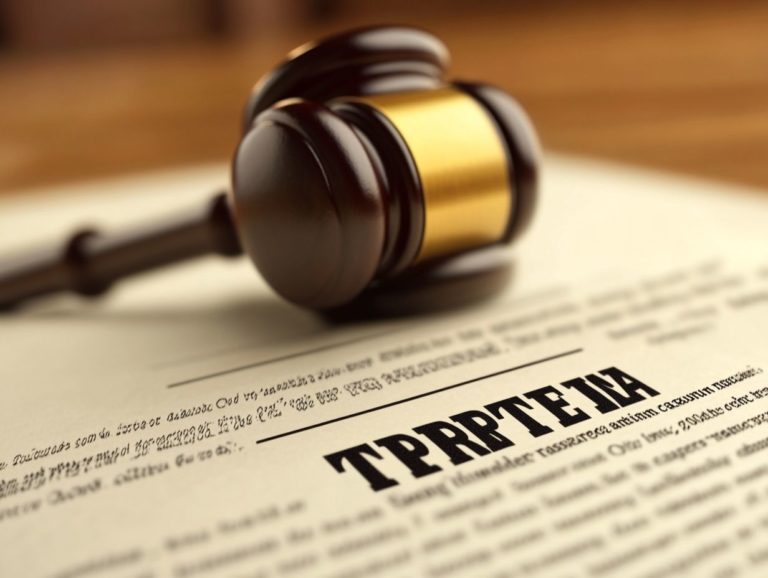The Connection Between Trademarks and Copyrights
In a landscape where creativity and innovation are the cornerstones of success, understanding trademarks and copyrights is vital for protecting your unique creations.
This article clarifies the definitions and distinctions between these two essential concepts, highlighting their significance and demonstrating how they work together to safeguard your ideas.
We will cover the registration process, explore effective legal strategies for enforcement, and tackle common misconceptions.
Immerse yourself in this knowledge to empower your creative pursuits and elevate your work to new heights!
Contents
- Key Takeaways:
- Understanding Trademarks and Copyrights
- The Importance of Protecting Intellectual Property
- How Trademarks and Copyrights Work Together
- How to Register for Trademarks and Copyrights
- Enforcing Trademarks and Copyrights
- Common Misconceptions About Trademarks and Copyrights
- Frequently Asked Questions
- What is the difference between trademarks and copyrights?
- How are trademarks and copyrights related?
- Can a trademark and a copyright be used together?
- What are the benefits of trademark and copyright protection?
- Can I trademark a copyrighted work?
- What happens if someone infringes on my trademark or copyright?
Key Takeaways:

- Trademarks and copyrights are distinct forms of protection for your creative ideas.
- These protections are crucial for businesses and creators, safeguarding unique ideas and preventing infringement.
- Trademarks and copyrights work together to provide comprehensive protection for a brand.
- The registration process and enforcement options vary, but both are necessary for full legal protection.
Understanding Trademarks and Copyrights
Understanding trademarks and copyrights is crucial for protecting your creative expression and business assets in today s competitive landscape.
Trademarks are unique identifiers that protect your brand identity, while understanding the role of copyright in business branding offers legal protections for your original artistic creations.
Both forms of protection are essential for maintaining exclusive rights to your creative contributions.
The U.S. Patent and Trademark Office manages trademark registrations, while the U.S. Copyright Office oversees copyright registrations.
This article delves into the definitions, differences, and significance of these two vital legal concepts, providing insights for navigating this complex terrain.
Definitions and Differences
Trademarks and copyrights each play vital roles in intellectual property, designed to protect unique identifiers and creative expressions.
Trademarks focus on symbols, logos, and brand names that set your goods or services apart in the marketplace. Copyrights preserve original works of authorship, including literature, art, music, and software.
A trademark grants you exclusive rights to use a mark with specific goods or services, preventing consumer confusion. Copyright protects the expression of ideas, covering formats like paintings, novels, and films.
Understanding these differences is essential for creators and businesses to effectively protect their intellectual property rights.
The Importance of Protecting Intellectual Property
Protecting intellectual property is essential for you as a creator, business owner, or industry leader. It secures your original expressions and commercial interests.
Intellectual property rights, such as trademarks and copyrights, allow you to maintain exclusive control over your innovative ideas and brand identities. This protection secures the economic value of your assets and fosters an environment where creativity can thrive, free from infringement or consumer confusion.
Grasping the significance of these protections enables you to defend your unique identifiers and creative pursuits. Don t wait to protect your creative work!
Take action to ensure your ideas are safe and secure.
Why Trademarks and Copyrights Matter
Trademarks and copyrights are vital because they create essential legal frameworks that shield you from infringement and prevent consumer confusion.
These protections also help forge your brand’s identity in the marketplace, enabling consumers to recognize and trust your products and services.
Without such safeguards, you risk losing the distinctive elements that set your business apart, which can lead to a decline in brand loyalty.
For instance, a survey revealed that 70% of consumers are more inclined to support brands they recognize, underscoring the crucial role of intellectual property creations of the mind, such as inventions and artistic works in fostering consumer trust.
Neglecting to protect these assets can lead to costly repercussions, as evidenced by the high-profile case of Apple versus Samsung, where both companies faced off over patent infringements that could potentially cost millions.
Such cases underscore the necessity of taking proactive steps to preserve your brand s integrity while reinforcing the importance of strong intellectual property protections.
How Trademarks and Copyrights Work Together

Trademarks and copyrights form a powerful alliance, and understanding the relationship between patents and copyrights enhances our ability to provide strong protection for safeguarding intellectual property.
This ensures that both your brand identity and artistic creations are legally protected, allowing you to focus on what you do best without the worry of infringement.
Examples of Overlapping Protection
You’ll find that trademarks and copyrights often overlap in their protections, particularly in industries where brand identity and creative expression are paramount. Understanding the relationship between trade secrets and copyrights can also be crucial in navigating these legal aspects.
Take, for example, a company s logo design. It can be copyrighted as an artistic work while simultaneously enjoying protection under trademark law as a representation of brand identity.
Unique packaging designs also typically fall into both realms; the innovative packaging can be copyrighted for its creativity, while its role as a brand identifier is protected by trademark rights.
In the software industry, interfaces featuring distinctive visual elements can be copyrighted, whereas the brand name and logo associated with the software are secure under trademark law.
By utilizing both types of protection, businesses can fortify their intellectual property rights, creating a robust defense against infringement while boosting their presence in the marketplace.
How to Register for Trademarks and Copyrights
Registering trademarks and copyrights is essential for you as a business owner or creator.
Protecting your unique creations is vital for your success! It s your way of securing intellectual property rights and preventing others from using your unique identifiers and creative works without permission.
The process entails submitting applications to the U.S. Patent and Trademark Office for trademarks and to the U.S. Copyright Office for copyrights.
This ensures that you gain legal recognition and protection under copyright and trademark laws.
By understanding the registration process, you enable yourself to confidently safeguard your brand identity and artistic creations.
Step-by-Step Process
The step-by-step journey of applying for trademarks and copyrights can feel intricate, but it s crucial for securing the legal protection your creations deserve.
Understanding the nuances of these applications is essential for anyone looking to safeguard their intellectual property.
- For trademarks, begin with a comprehensive search of existing marks to ensure your idea stands out, followed by filing your application with the U.S. Patent and Trademark Office (USPTO) or the appropriate authority.
- For copyright, registration can be conveniently started online through the United States Copyright Office. Here, you’ll need to submit your original works along with the necessary forms and fees.
To navigate these processes smoothly, it s wise to maintain meticulous records, double-check all submissions for accuracy, and seek legal advice when necessary.
This diligent approach minimizes the chances of errors and maximizes the likelihood of a seamless application experience.
Enforcing Trademarks and Copyrights
Enforcing trademarks and copyrights is crucial for preserving the integrity of intellectual property rights and safeguarding against infringement.
By actively protecting these assets, you uphold your creative endeavors and ensure that your unique contributions remain distinguishable and respected in the marketplace.
Legal Options and Strategies

When you encounter trademark or copyright infringement, you have powerful legal options at your fingertips to protect your rights. These options may include engaging in settlement negotiations to reach an amicable agreement without the need for court intervention.
You can also utilize mediation services to facilitate constructive discussions between the parties, or, if necessary, pursue formal lawsuits.
It s essential for you to keep detailed records of your works and any correspondence related to the dispute. This documentation can significantly strengthen your claims and serve as crucial evidence during negotiations or legal proceedings.
Talking to legal experts in intellectual property will help you understand your rights better.
Common Misconceptions About Trademarks and Copyrights
Many individuals harbor misconceptions about trademarks and copyrights, which can create significant confusion for creators and businesses concerning their intellectual property rights.
Understanding these nuances is crucial for navigating the complex landscape of intellectual property, which refers to creations of the mind, like inventions, artistic works, and symbols.
Debunking Myths and Clarifying Facts
Debunking the myths surrounding trademarks and copyrights is essential for grasping the true essence of intellectual property rights. Many people operate under the misconception that all creative works are automatically protected the moment they come into existence.
While copyright does indeed provide a level of protection, you should know that registering a copyright grants you much stronger legal safeguards. For instance, it may surprise you to discover that formal registration is necessary if you ever want to sue for damages in the event of infringement.
Another common myth is that trademarking a name or logo guarantees indefinite rights. The reality is that trademarks must be actively used and renewed to maintain their protection.
By understanding these critical distinctions, you can skillfully navigate the complexities of intellectual property, enabling yourself to effectively safeguard your innovations.
Frequently Asked Questions
What is the difference between trademarks and copyrights?
Trademarks and copyrights are two types of intellectual property protection, but they serve different purposes. A trademark protects a brand’s name and logo, while a copyright protects original creative works such as books, music, and art. Think of trademarks as the face of your business and copyrights as the protection for your creative output.

While they serve different purposes, trademarks and copyrights are both forms of intellectual property and are governed by similar laws. Both protect the creators of original works and prevent others from using their creations without permission.
Can a trademark and a copyright be used together?
Yes, a trademark and a copyright can be used together to provide comprehensive protection for a brand. For example, a company may have a trademark for their brand name and logo, as well as a copyright for their website design and content.
What are the benefits of trademark and copyright protection?
Why should you care about trademark and copyright protection? These rights grant you exclusive control over your creations, allowing you to profit and defend against unauthorized use!
Can I trademark a copyrighted work?
No, a copyrighted work cannot be trademarked. Copyright protects original creative works, while a trademark protects a brand’s name and logo. However, a logo or other creative element within a copyrighted work can be separately trademarked.
What happens if someone infringes on my trademark or copyright?
You must take action if someone infringes on your rights! This could include sending a cease and desist letter, filing a lawsuit, or seeking damages for financial losses. It is important to register your trademark and copyright to have stronger legal protection in such situations.






